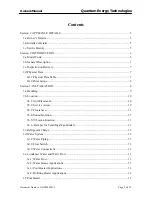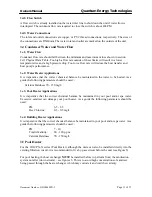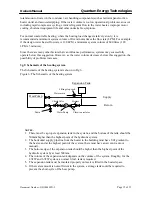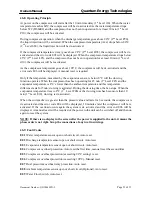
Owners Manual
Quantum Energy Technologies
3b.3: Clearances
The flow of air to and from the evaporator coils must not be restricted. Restricting airflow or
allowing air recirculation will result in a decrease in unit performance and efficiency and can lead
to a malfunction. There must be no obstruction above the unit that would deflect discharge air
downward where it could be re-circulated back to the inlet of the evaporator coil. The evaporator
fan is a propeller type and will not operate with ductwork on the fan outlet.
Install the unit with enough side clearance for air entrance to the coil and for servicing. Provide
service access to the evaporator, compressor, electrical control panel and piping components as
shown in Figure 3. Do not block access to the unit with piping or conduit. Do not block airflow
from the top.
Do not allow debris to accumulate near the unit. Air movement may draw debris into the
evaporator coil causing air starvation.
Give special consideration to low ambient operation where snow can accumulate. Keep evaporator
coils and fan discharge free of snow or other obstructions to permit adequate airflow.
3b.4: Sound Isolation
The sound level of the Quantum water heater is suitable for most applications. When additional
sound reduction is necessary, locate the unit away from sound sensitive areas. Avoid locations
beneath windows or between structures where normal operating sounds may be objectionable.
Reduce structurally transmitted sound by isolating water lines, electrical conduit and the unit itself.
Use wall sleeves and rubber isolated piping hangers to reduce transmission of water or pump noise
into occupied spaces. Use flexible electrical conduit to isolate sound through electrical conduit.
Spring isolators are effective in reducing the low amplitude sound transmission through the base
for isolation in sound-sensitive areas (i.e. such as on the roof of a building).
3b.5: Vibration Isolation
Vibration isolators are recommended for all roof-mounted installations or wherever vibration
transmission is a concern.
Installation of spring isolators requires flexible piping connections and at least one meter of
flexible conduit to avoid straining the piping and transmitting vibration and noise.
The unit should initially be placed on shims or blocks at the listed free height. When all piping,
wiring, flushing, charging etc. is completed, the springs are adjusted upward to loosen the blocks
or shims that are then removed.
A rubber anti-skid pad under the unit can form part of the isolation.
3b.6: Damper for Centrifugal Fan Models
Adjustable damper must be installed for each of the fan outlet for the centrifugal fan models to
prevent the fan to be overloaded.
Document Number : QDC0049PD-5
Page 11 of 33












































